As far as playing guitar goes, country songs aren’t usually very complex. In fact, their simple chords and straightforward rhythm make them a great starting point for beginner guitarists. The trick to growing your repertoire is to pick up and master a bunch of heavily used chord progressions of the genre.
Don’t go scouting for lessons just yet, as I’ll be taking you through the most essential and common country chord progressions right here.

You’ll find that the chords taught below can be found in almost all of your favorite country songs. If you’re interested, we also have a huge list of our favorite country songs that are easy to play on guitar here.
Table of Contents
- 1. I – IV – V
- 2. I – V – vi – IV
- 3. i – bIII – bVII – i
- 4. V – IV – I
- 15. 12-bar Blues
- 6. i – VII – IV – IV
- 7. I – ii – V7 – I
- 8. I – V
- 9. I – IV – I (4x) – V (4x) – I (2x) – V (2x) – I (2x)
- 10. I – IV – I – V
- 11. I – iii – IV – I – I – iii – IV – V
- 12. 8-bar Country Progressions
- 13. vi – IV – I – V
- 14. i – VI – VII – III
- 15. I – V6 – vi – I6/4 – IV – IV – V
1. I – IV – V
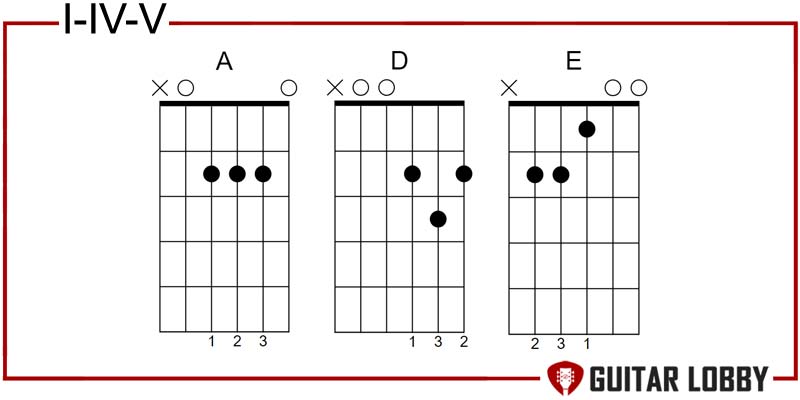
I call the tonic (I), predominant (IV), and dominant (V) the usual suspects chords of country. More often than not, you’ll find these three doing most of the heavy lifting in country music. The I – IV – V chord progression is popular in many genres, from blues to pop. But in country music, the prominence of this sequence stands at another level.
The I – IV – V – I was inherited from the acoustic-led Old Time, the earliest form of country music where most tunes were built using just three chords. In the key of A major, this progression is A – D – E. Jimmy Davis and Charles Mitchell’s iconic “You Are My Sunshine” use these exact chords in this very order in a 4/4 time signature.
This progression also works because each chord is performing a specific function. For starters, the tonic chord provides the feeling of home or stability. The predominant builds tension, which peaks with the arrival of the dominant chord. You’re finally given a sweet finish when the dominant resolves to the tonic.
As I said, there are countless country tracks that use this chain of chords in different keys. You’ll also come across songs with dominant 7th chords like IV7 or V7 to spice up the melody and add a bluesy touch. “Blue Suede Shoes” by Carl Perkings uses a I – IV7 – V7 sequence for a rockabilly-meets-blues vibe.
Popular Songs That Use This Progression: “You Are My Sunshine” (Jimmy Davis), “Man of Constant Sorrow” (Soggy Bottom Boys), “Summertime Blues” (Eddie Cochran), “Ring of Fire” (Johnny Cash), “When the Sun Goes Down” (Kenny Chesney)
2. I – V – vi – IV
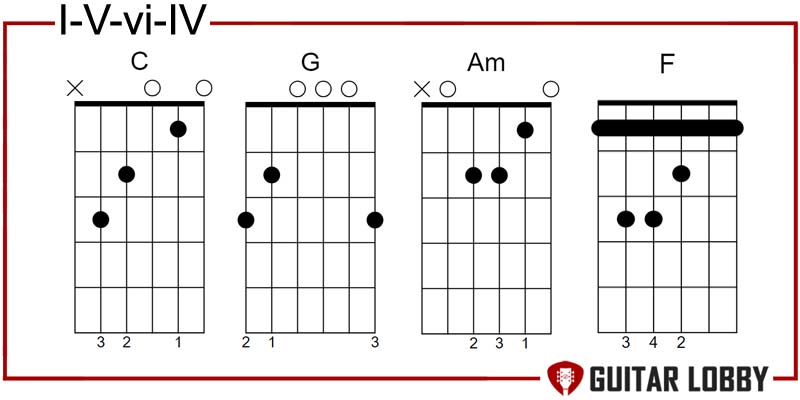
Unlike jazz, blues, and indie, country music songwriters are mainly seen toying around with major chords. They bank upon simple harmonies to underline the song’s message, which usually revolves around practical wisdom, country living, love, loss, betrayal, and faith. If there’s ever a minor chord, it’s usually the minor sixth (vi) chord, which brings us to the I – V – vi – IV progression.
As you can see, in this sequence, the dominant (V) precedes the predominant (IV) and the submediant (vi) chord. So, instead of a perfect resolution associated with the V moving back to I, you get a softer finish with the IV return to the tonic chord. The element of mystery and suspense is certainly higher in this chord sequence thanks to the movement of V going to vi. In music theory, this is known as Deceptive Cadence.
This progression is extremely popular across genres, especially pop, because it leaves listeners craving more. Don’t believe me? Play this progression in the key of C major as C – G – Am – F. Notice how it gives off an element of wanting to go home but carrying on for the sake of the storytelling. In country music, you can hear it in many of Taylor Swift’s songs, such as “Out of the Woods” and “Clean.” You can also hear this in Darius Rucker’s famous “Wagon Wheel,” – a beginner-friendly song in the key of G major with the G – D – Em – C chord pattern carrying the entire tune.
Popular Songs That Use This Progression: “What About Now” (LoneStar), “Out of the Woods” (Taylor Swift), “Wagon Wheel” (Darius Rucker), “Take Me Home, Country Roads” (John Denver).
3. i – bIII – bVII – i
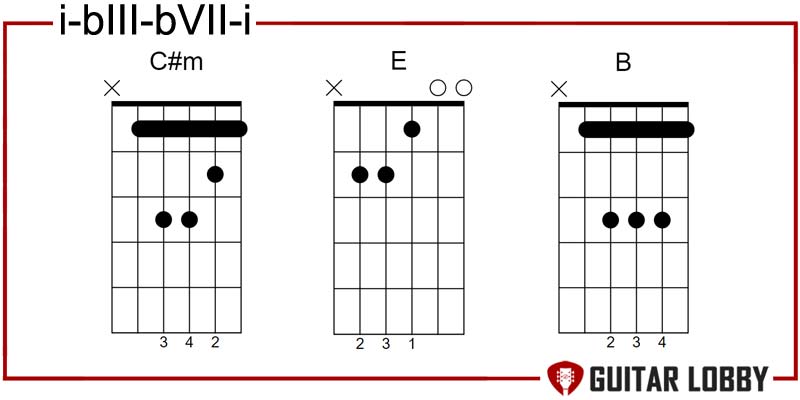
This i – bIII – bVII – i progression powers one of the most recognizable country songs of all time: Dolly Parton’s “Jolene.” The way Parton played it in the original is in the key of C#m with the chords C# minor, E major, and B major. Now, in the scale of C sharp minor, the tonic is obviously C#m. The E major is the III chord, and the B major is the VII chord. So, the chord progression becomes C#m – E – B – C#m. Here’s a look at all the chords of this scale:
i = C#m ii° = D# dim III = E iv = F#m v = G#m VI = A VII = B
The minor key and the way the chords are cleverly sequenced help amplify the desperation and plight of the protagonist. After all, she’s begging a woman named Jolene to leave her husband alone.
Playing-wise, these are tricky chords for a beginner. One way to avoid dealing with barre chords like C#m and B is to play it like most guitarists: with a capo on the 4th fret. This gives you access to open chords of Am, C, and G in the key of A minor, making playing along with Parton’s original a cakewalk.
Popular Songs That Use This Progression: “Jolene” (Dolly Parton).
4. V – IV – I
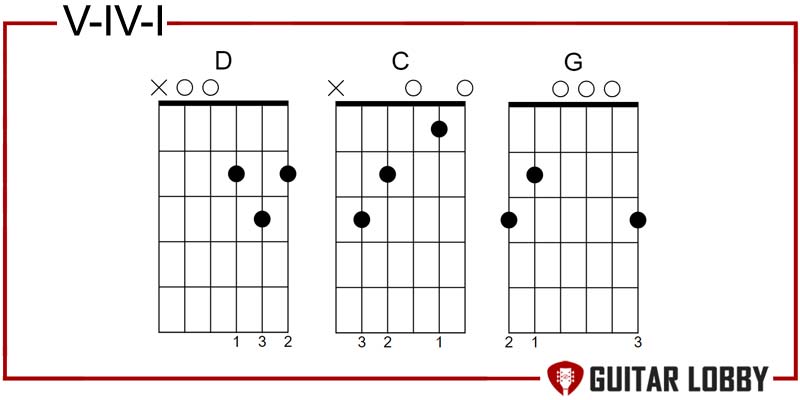
The ‘60s and ‘70s saw the country genre transform by incorporating elements of other styles like rock. A popular example of country rock is Lynyrd Skynyrd’s 1974 classic “Sweet Home Alabama.”
It’s one of the first tunes a guitar player learns, and for a good reason. Even in its simplest arrangement, this song sounds super catchy. And a large part of the credit goes to this infectious three-chord progression. Note how it involves the same three chords discussed in the first example but with a changed order: V – IV – I instead of I – IV – I. As you can make out, the progression starts with the dominant, followed by the predominant, which then resolves to the tonic. This order creates a lovely walking-down effect.
In the song, the three chords used are D – C – G, though there is some confusion about the tonic center of the song. Some think it’s in the key of G major, while others feel it’s in D Mixolydian. There’s a third camp that feels it cycles between the two keys. I play it in G major key, which is made up of the following chords:
I = G ii = Am iii = Bm IV = C V = D vi = Em vii⁰ = F#dim
Had the key been D Mixolydian, the use of chords D – C – G would have made the progression I – bVII – IV.
Popular Songs That Use This Progression: “Sweet Home Alabama (Lynyrd Skynyrd).
15. 12-bar Blues
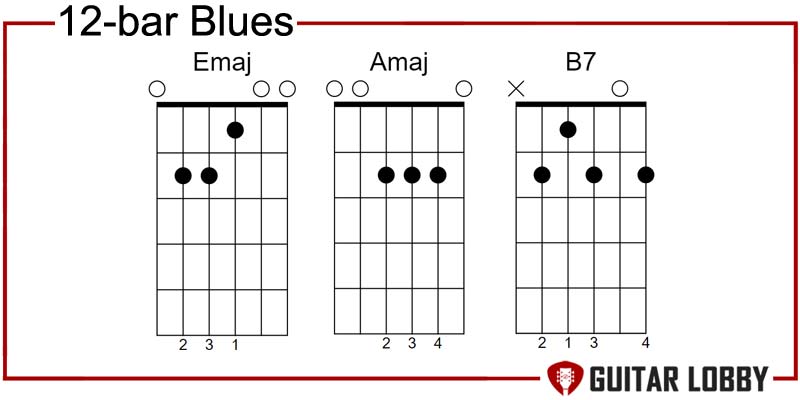
Country music is considered a melting pot of many genres, like blues, bluegrass, jazz, and Appalachian folk. So, it’s not really a surprise that one of the most common blues progressions has found its way into this genre. I am talking about basic 12-bar blues and its many variations.
An excellent example of 12-bar blues in country is Johnny Cash’s timeless hit “Folsom Prison Blues.” Released in the mid-50s, the charismatic and feisty track became one of Cash’s best-loved tunes. And that’s saying something. You can play this track in the key of E major with the E, E7, A, and B7 chords. These are the usual suspects or the ever-popular I, IV, and V chords. However, the V chord is a dominant 7th chord for that extra bluesy vibe.
It’s a 12-bar progression, which kicks off with the I or the E chord for four bars, followed by the IV or the A chord for two bars. The E chord is played again for two more bars, followed by the B7 or V chord for two bars, and then finally ending with two bars of the E chord. Here’s what it looks like in Roman numerals: I – I – I – I – IV – IV – I – I – V – V – I – I. And this is how Cash plays it in the key of E major: E – E – E – E – A – A – E – E – B7 – B7 – E – E.
The easiest way to play these chords is in the open position, especially since you’ll be tackling Cash’s tricky signature strumming pattern next. There are plenty of country tracks that use the 12-bar blues, like the ones listed below.
Popular Songs That Use This Progression: “Folsom Prison Blues” (Johnny Cash), “God’s Gonna Cut You Down” (Johnny Cash), “Going Up the Country” (Canned Heat).
6. i – VII – IV – IV
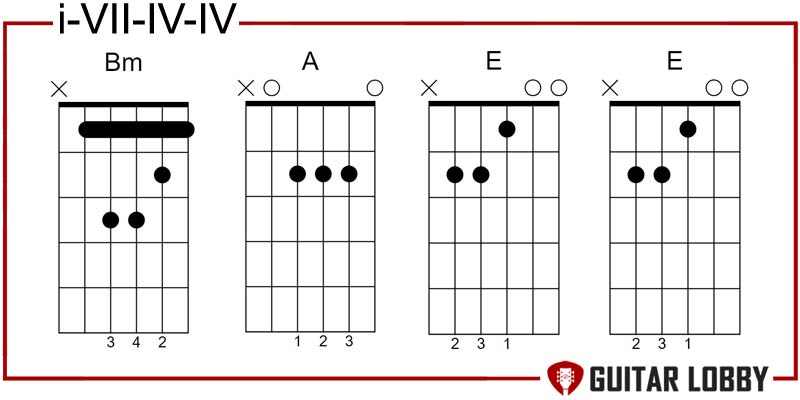
There’s no denying that Chris Isaak’s “Wicked Game” is one of the most loved tunes in modern country. It is sultry, romantic, and moody and manages to linger in the listeners’ minds long after it’s over. What’s fascinating is the progression that pretty much involves only three basic chords but sounds dark, powerful, and emotional.
As you can probably make out by now, the i – VII – IV – IV sequence indicates we’re looking at a minor chord progression. In this song, the i chord is a B minor chord, and this is what the chords in the key of B minor look like:
i = Bm ii° = C# dim III = D iv = Em v = F#m VI = G VII = A
In a natural minor key, the iv is a minor chord. But if you look at the song’s tabs, the chords used are Bm, A, and E, in a Bm – A – E – E pattern. So, where did the E major chord come from, as the key of B minor clearly has a minor iv chord? Well, it so happens the song uses chords from the B Dorian scale, which is the same as the B minor scale except for the raised 6th note: a G# instead of G. The raised 6th gives us an E major chord, allowing us to play the Bm – A – E – E progression as heard in Isaak’s original. This is one of those country chord progressions that you’ll see everywhere, and it’s one I highly recommend learning.
Popular Songs That Use This Progression: “Wicked Game”(Chris Isaak).
7. I – ii – V7 – I
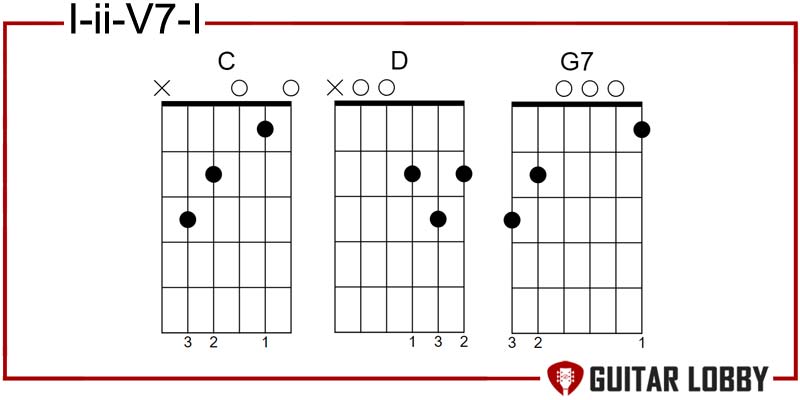
This progression is incredibly popular thanks to the use of authentic cadence or the V to I motion that gives a strong finish to the phrase. It’s also got a supertonic (ii) chord thrown in to weave a sense of suspense. There are plenty of tunes that make use of this progression. The A section of “Hey, Good Lookin’” by Hank Williams Sr. and the chorus of “I am a Yankee Doodle Dandy” are two examples that immediately spring to mind when I look at this chord pattern.
In “Hey, Good Lookin’,” Williams uses the key of C major, which should ideally make the progression look like C – Dm – G – C. However, the actual progression used is C – D – G7 – C. What Williams has done here is use secondary dominant – a popular songwriting technique to up the catchiness and drama.
The D major chord is a dominant chord borrowed from the key of G. So when you move from D to G in the progression, you get a stronger pull. Why? Because the D chord is the dominant of G and also leads to it. These are just some tried and tested tricks songwriters use to spice up standard chord progressions.
Popular Songs That Use This Progression: “Gentle on My Mind” (Glen Campbell and Johnny Cash), “Hey, Good Lookin’” (Hank Williams).
8. I – V
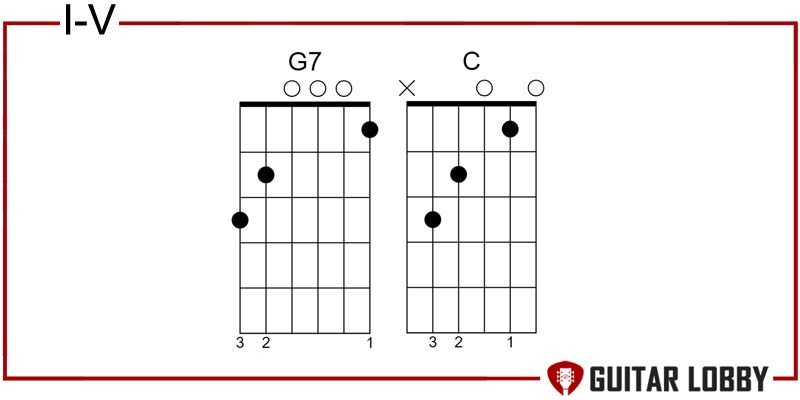
This might just be the easiest country progression made up of two of the three stalwart chords of country. In this progression, we use only the tonic and the dominant to create a simple harmony, like the one heard in Hank Williams and Lucinda Williams’ 1954 classic “Jambalaya.” The song is set in the key of C major and pairs the tonic chord or C major chord with G7, which is a dominant 7th chord.
When you get down to playing the song, you’ll need to play two bars of C chord, followed by four bars of G7, and ending with two bars of C. So, eight bars in all, over and over again. The Carpenters’ rendition of this song also features just two chords but in a different key. They use the G major key, making their progression G – D – G. In fact, you can use the I and V chords from any key to play this song.
The I – V movement is considered the bedrock of folk music and can be traced back to traditional songs that originated centuries ago, such as “Alouette” and “Camptown Races.” In the modern country, Bonnie Raitt’s “Something To Talk About” or Billy Ray Cyrus’ “Achy Breaky Heart” are other tracks that can help you master this progression. While Raitt’s Grammy-winning single uses the C – G7 – C sequence in the C major key, Cyrus’ song is based in the key of A and relies on A – E – A chords.
Popular Songs That Use This Progression: “Jambalaya (Hank Williams), “Something to Talk About” (Bonnie Raitt), “Achy Breaky Heart” (Billy Ray Cyrus).
9. I – IV – I (4x) – V (4x) – I (2x) – V (2x) – I (2x)
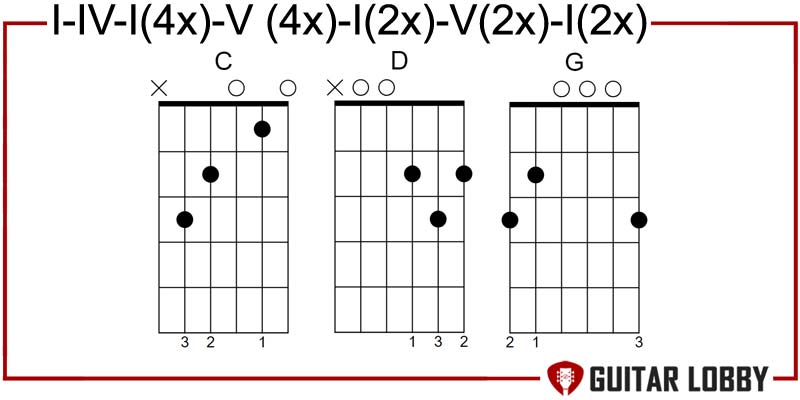
We cannot have a list of popular country chord progressions without a mention of the great Carter Family. Founded by A.P. Carter, the Carter Family rose to prominence in the late 20s, collecting and recording traditional folk tunes. Their style had a huge impact on bluegrass, country, and gospel music – not to mention Maybelle Carter’s genre-defining fingerpicking technique.
The Carters were the first family of country music. Some of the most well-known names in country music belonged to this group, such as A.P. Carter, Maybelle Carter, Anita Carter, Helen Carter, and June Carter. Even the legendary Johnny Cash toured extensively with the group after marrying June.
This unusually long chord sequence that we have here can be heard in the group’s well-loved “Keep on the Sunny Side.” While the original was performed in the key of Bb major, you can use a capo on the third fret and play it in the key of G major.
In G major, the sequence you’ll be tackling would look something like this: G – C – G – G – G – G – D – D – D – D – G – G – D – D – G – G. Don’t be alarmed by its length, as you can see it’s just a variation of the country mainstay I – IV – V progression.
Popular Songs That Use This Progression: “Keep on the Sunny Side” (The Carter Family).
10. I – IV – I – V
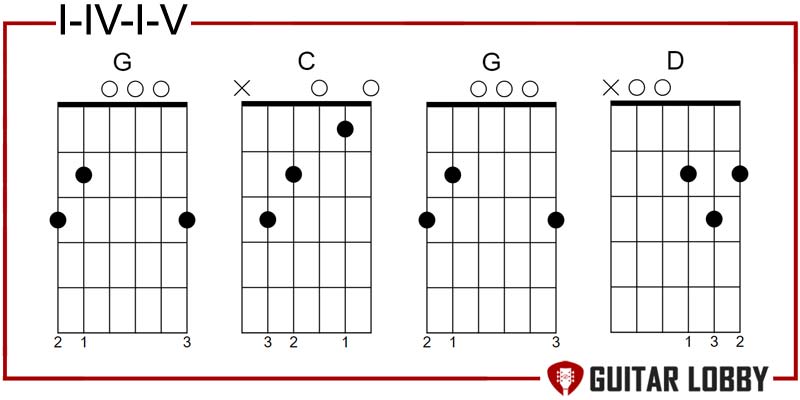
At the start of this article, I talked about bluegrass’s contribution to shaping modern country sound. Well, the progression you’re looking at is one of the most important bluegrass chord sequences. It uses the building blocks chords I, IV, and V in a I – IV – I – V pattern.
One way to look at this is as a combination of two common progressions, I to IV and I to V. When the two are played together, it creates a fun walk-up and walk-down effect, which is very popular in bluegrass. In the key of C major, this sequence would be putting together a C chord moving to an F chord with a C going to G. “Goodbye Earl” by Texas-based country band Dixie Chicks is perfect for coming to grips with the C – F – C – G progression.
Outside of bluegrass or country, you can also sample this progression in the chorus of Van Morrison’s mega-hit rocker “Brown Eyed Girl.” The heartwarming single is in the key of G and uses the G – C – G – D progression throughout.
Popular Songs That Use This Progression: “Goodbye Earl” (Dixie Chicks), “Into the West” (Annie Lennox), Chorus of “I Won’t Back Down” (Tom Petty).
11. I – iii – IV – I – I – iii – IV – V
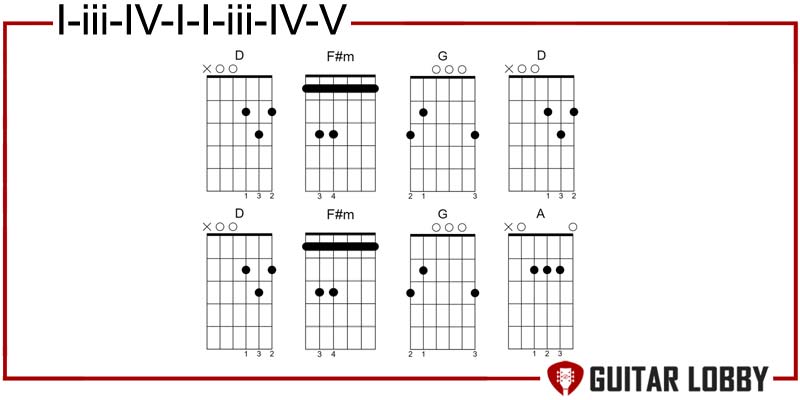
In the early days of country, Hank Williams Sr. could get away with just a I and a V chord in “Jambalaya” or a I, IV, and V in “I’m So Lonesome I Could Cry.” The melody would still sound so great. But over time, country music started blending with other genres. The progressions, especially in the verses, got more elaborate and sophisticated. Meanwhile, the choruses stuck to the laid-back country style.
“Amarillo by Morning” by George Strait is an excellent case in point. The country staple was released in 1982 and painted the adventurous life of a rodeo cowboy. You’ll hear the following progression in the verses: I – iii – IV – I – I – iii – IV – V.
The song uses the key of D major in the first two verses before changing the key to E in the last verse. Here are all the chords in the key of D:
I = D ii = Em iii = F#m IV = G V = A vi = Bm vii⁰ = C# dim
So, that would make the verse progression look like D – F#m – G – D – D – F#m – G – A. You’ll hear the same progression in the last verse, except in the key of E.
Popular Songs That Use This Progression: “Amarillo by Morning” (George Strait).
12. 8-bar Country Progressions
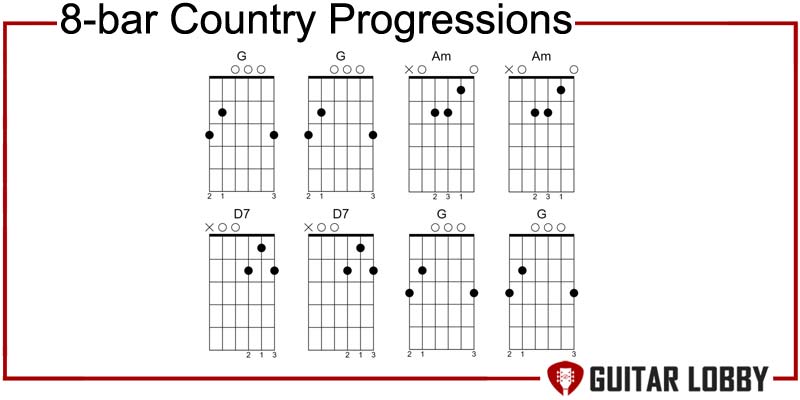
The I, IV, and V chords are the building blocks of blues as well as country music. You’ll find plenty of country songs that use the common time of 4/4 and tap into either a 16-, 12-, or 8-bar blues progression. In fact, pairing an 8-bar blues sequence in verse with a 16-bar blues progression in the chorus is pretty common in this genre.
Bobby Helms’ “Fraulein” and Guy Mitchell’s “Heartaches by Number” are some examples that use the 8-bar blues in the verses. In “Fraulein,” Helms uses the key of A major and the A, A7, D, E7 chords in a I – I7 – IV – IV – V7 – V7 – I – I progression.
While we’re on the topic of 8-bar progressions, there’s another one that is a bit different but merits a mention. The sequence uses I, ii, and V7 chords in the following order: I – I – ii – ii – V7 – V7 – I – (I V7). In the key of G major, it would look like G – G – Am – Am – D7 – D7 – G – (G – D7).
You can hear it in action in George Jones’ “He Stopped Loving Her Today.” Released in 1980, this heartbreaking tale of an abandoned lover is hailed in many polls and surveys as the greatest country song of all time. It was also made a part of the Library of Congress’s National Recording Registry.
Popular Songs That Use 8-bar Progression: “Fraulein” (Bobby Helms), “Charlie’s Shoes” (Billy Walker), “Pick Me Up on Your Way Down” (Billy Walker), “Heartaches by the Number” (Ray Price).
13. vi – IV – I – V
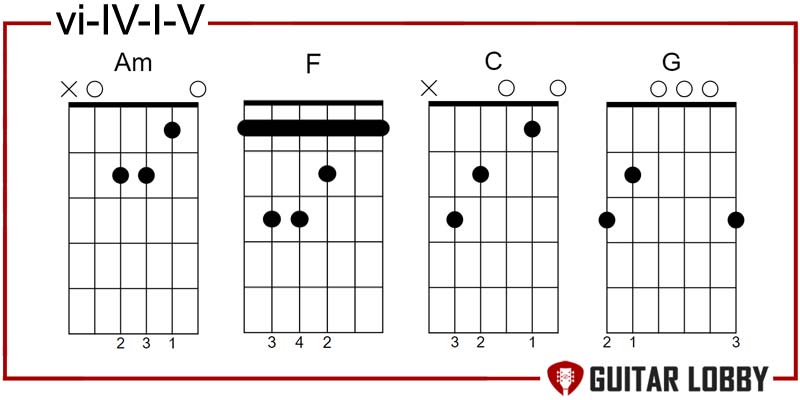
The vi – IV – I – V is a variation of the hugely popular I – V – vi – IV (1-5-6-4) but starts off with a submediant chord instead of the tonic. Despite having the same chords from the scale scale, the vi – IV – I – V sounds more somber and dramatic than 1-5-6-4. Why? Because the vi and IV chords support melancholy. You can detect a hint of pessimism, like losing hope. Things take a turn for the better when the IV is followed by the I and V chords. Finally, ending the sequence on a sunnier and more positive note.
This peculiar order helps create an emotional and inspirational experience for the listeners. Play this pattern in the key of C major with Am – F – C – G, and tell us if you agree.
The obsession for this set of chords began with Joan Osborne’s “One of Us.” The progression’s versatility soon made it popular with songwriters across genres. Here’s something fun – you can use this progression in major as well as minor keys. However, the sequence would change in a minor key to i – VI – III – VII.
In country music, you can hear this progression in Kenny Chesney’s “Come Over” in the verses of Keith Urban’s “You’ll Think of Me” and “So Small” by Carrie Underwood. In “Come Over,” the chord pattern is bbm7 – Gbsus2 – Db – Ab, which is vi7 – IVsus2 – I – V in Db major.
A Taylor Swift fan? Then you would’ve heard this progression in her uptempo country rocker “Sparks Fly.” It’s in the F major key and features the vi – IV – I – V in all parts except pre-chorus.
Popular Songs That Use This Progression: “Come Over” (Kenny Chesney), “So Small” (Carrie Underwood), “Sparks Fly” (Taylor Swift), “You’ll Think of Me” (Keith Urban).
14. i – VI – VII – III
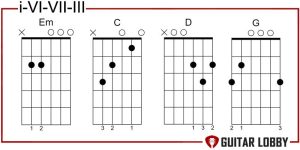
This unusual chord mix can be heard in many country hits, including Neil Diamond’s “Heart of Gold” and the chorus of “I Knew You Were Trouble” by Taylor Swift. There’s a name for this group of chords. It’s called the ‘Humoresque’ progression. And the earliest example of this pattern is Czech composer Antonin Dvořák’s piano cycle, “Humoresques.”
The sequence begins with the tonic in a minor key, followed by VI, VII, and III chords. In other words, it uses all three major chords that you’d find in a minor key. No wonder it sounds inspirational, optimistic, and powerful! There’s another reason why this progression sounds so fantastic. In its relative major key, this is almost the same as playing the ultra-popular four chords we explored in the previous example, but in a slightly different order.
With the astonishing popularity of the i – VI – VII – III in Japanese pop and Anime, it’s safe to say that this set of chords work well together. In “Heart of Gold,” you can hear this progression shine in the key of E minor. Here are all the chords you’ll find in that key.
i = Em ii° = F# dim III = G iv = Am v = Bm VI = C VII = D
The progression runs as Em – C – D – G in the verses and chorus of the song. So, if you’re looking to give this sequence a go, Diamond’s magnum opus would be a good place to start.
Popular Songs That Use This Progression: “Heart of Gold” (Neil Diamond), “I Knew You Were Trouble” (Taylor Swift).
15. I – V6 – vi – I6/4 – IV – IV – V
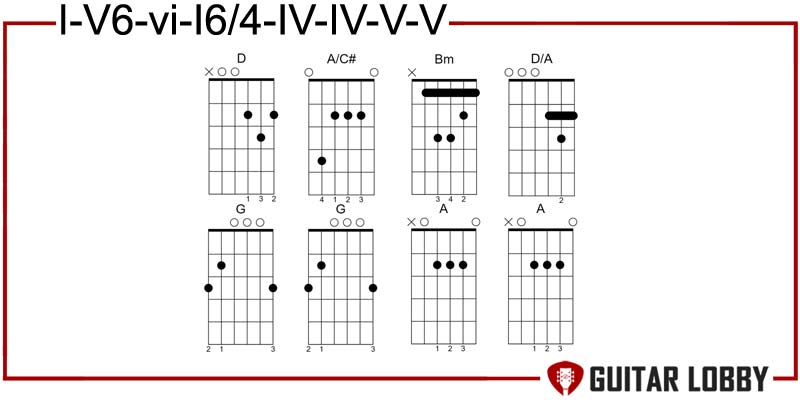
I admit this isn’t the easiest progression on the list. But learning it will help you add a chart-topping country hit to your repertoire. I am talking about Brad Paisley’s ” Mud on the Tires.”
The track is set in the key of D major, and most of the progression is built around the good ol’ I, IV, vi, and V chords, but there are some outliers. The V6 chord in the song is played using an A/C#. Meanwhile, the D/A is considered an I6/4 chord. In music theory, these are inversions where you’re basically repositioning the notes of a chord.
The V6 tells it’s a first inversion with the third as the bass note, whereas the I6/4 indicates a second inversion with the fifth in the bass. For example, the V6 or A/C# shows that out of an A major chord’s notes A – C# – E, C# is the bass note.
Now that we’ve discussed the funny-looking chords, here’s what the entire progression looks like in the key of D major: D – A/C# – Bm – D/A – G – G – A – A.
Popular Songs That Use This Progression: “Mud on the Tires” (Brad Paisley).
A Little Bit About Country Music and Chords
Country roots can be traced to the 17th century in the Appalachian region of North America. One of the earliest forms of country was ‘Old Time’ – a folk dance style led by stringed instruments, such as fiddle, banjo, and mandolin. It is said to have arrived from the British Isles and Europe along with the settlers. Old time, along with Appalachian folk, blues, and bluegrass, set in swing the birth of country music. Over time, the genre became known for its heartwarming dance tunes and ballads about the life of working-class Americans.
In the late 1920s, from the original recording hub of Bristol, Tennessee, the influence of country music spread far and wide. A number of icons emerged in the scene. The Carter Family and Jimmie Rodgers set the ball rolling as the first generation of country music. Meanwhile, Carl Perkins and Johnny Cash diversified it by blending it with rock and roll. In the 1970s, John Denver made the genre famous all over the world with his iconic “Country Roads,” “Rocky Mountain High” and “Annie’s Song.”
Foot-stomping catchiness notwithstanding, country music is not known for being the most experimentative style. You won’t come across a lot of unusual chord shapes, key changes, chord extensions, and alterations. Country musicians know what works for them and prefer sticking to the same scales, a handful of chord progressions, and a generous use of syncopated rhythms.
However, over the past couple of decades, this genre has embraced elements of rock, pop, and hip-hop to morph into something very mainstream. The emergence of styles like country rock, Southern rock, country pop, and country rap is a result of that diversification.
Final Thoughts:
Despite the common progressions, limited scales, and major keys, calling country music simple couldn’t be further from the truth. It is deceptively nuanced. And learning some of the progressions we explored today will help you enormously in your country music journey. After all, these chord patterns are the heart of country music. Whether you want to learn honky tonk classics, bluegrass songs, soft rockers, or modern Nashville gems, these progressions will help you expand your country repertoire or build it up from scratch.

My name is Chris and I’ve had a passion for music and guitars for as long as I can remember. I started this website with some of my friends who are musicians, music teachers, gear heads, and music enthusiasts so we could provide high-quality guitar and music-related content.
I’ve been playing guitar since I was 13 years old and am an avid collector. Amps, pedals, guitars, bass, drums, microphones, studio, and recording gear, I love it all.
I was born and raised in Western Pennsylvania. My background is in Electrical Engineering, earning a Bachelor’s degree from Youngstown State University. With my engineering experience, I’ve developed as a designer of guitar amplifiers and effects. A true passion of mine, I’ve designed, built, and repaired a wide range of guitar amps and electronics. Here at the Guitar Lobby, our aim is to share our passion for Music and gear with the rest of the music community.
